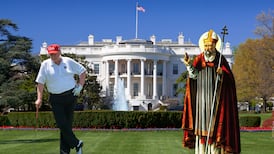At the time of Bloody Sunday, 30 years ago tomorrow, I was 13. I remember the burning of the British embassy in Dublin.
The stark black-and-white footage of the massacre on RTE's Seven Days for which the only commentary was Tony McMahon's astonishing, grief-stricken rendition of the great Irish lament, Marbhna Luimni. The black flags on the streets.
My father telling us, calmly and in sorrow, that we would soon all be heading for the Border with guns. The graffiti chalked up on public buildings in Dublin: "Dirty baker's Derry dozen." The sense that history had taken an irreversible turning towards a once-and-for-all fulfilment of Irish destiny.
I wonder now if the leadership of the Republican movement ever looks back and wonders how it lost all of that.
The unleashing of British state violence at its most naked and unapologetic had handed the political and moral high ground to the IRA. Though the memory of it was subsequently edited out of the collective consciousness of the Republic, Bloody Sunday produced a virtual consensus in favour of the IRA among the Catholic population north and south. The civil rights agenda was replaced by the United Ireland agenda.
John Hume famously said on RTÉ that many of his Bogside constituents "feel now that it's a united Ireland or nothing". The Minister for Foreign Affairs, Dr Paddy Hillery, arriving in New York to address the UN, said simply: "From now on my aim is to get Britain out of Ireland." A cool observer such as the BBC correspondent John Simpson felt that, in the months after Bloody Sunday, the Republic was "coming close to outright revolution . . . the whole structure of the country seemed to shake beneath our feet."
I was certainly a part of that consensus.
Even in adolescence, when things are normally confused, all of this seemed entirely simple. The British presence had lost every vestige of legitimacy. The IRA, Official or Provisional, (in the intense tribal bonding that followed Bloody Sunday, the difference seemed irrelevant) was the instrument of justice and retribution.
It had, as far as mainstream public opinion in Catholic Ireland was concerned, extraordinary latitude. The Provos' claim that 1972 would be "the year of victory" seemed credible.
If nasty things had to be done in the short final push towards that historic accomplishment, so be it.
The squandering of that huge hoard of public approval must rank among the great examples of political ineptitude in Irish history. In my case, and I think I was fairly typical at the time, my Provo phase lasted exactly 34 days until March 4th, 1972. It survived during, what I would now see as an especially disgusting incident, the Official IRA's bomb attack on the Parachute Regiment headquarters in Aldershot which killed five women cleaners, a gardener and a Catholic chaplain
At the time, I believed the Officials' claim that these casualties were fakes, and that in fact a dozen Para officers had been killed. To me, and I suspect to very many people in the Republic, that seemed like justice.
No such self-delusion was possible on March 4th, however, when the Provos bombed Saturday afternoon shoppers in the Abercorn bar and restaurant in the centre of Belfast. Two young Catholic women, Ann Owens and Janet Bereen were killed.
Around 70 people were injured, many of them permanently mutilated. What got to me at the time was not the casualties, though, but the details that made them real.
I vividly remember reading - I think in the Irish Press - that two of the victims were sisters who had been shopping for a wedding dress. One of them lost both legs, an arm and an eye. The other lost both legs. I also remember that the father of one of the women who was killed was a doctor at the Royal Victoria Hospital who worked to save the victims, unaware that his own daughter was among them.
Much of the rage which still hovers around the Bloody Sunday massacre stems from the way the British state added insult to injury with the disgraceful Widgery Inquiry.
Lord Widgery dishonoured the dead both by essentially blaming them for their own deaths and by suggesting that some of them had handled guns or bombs on the day. The added injustice of this whitewash was effectively acknowledged by the British government with the establishment of the Saville Inquiry.
Yet the Bloody Sunday dead were equally dishonoured by what both wings of the IRA did in their name. Widgery's dismissal of the innocent victims was prefigured by the Official IRA's claim that the ordinary working people killed by its bomb in Aldershot were merely a figment of official propaganda. There has never been an acknowledgement of this double injustice to the families of Jill Mansfield, Margaret Grant, Thelma Bosley, Cherie Munton, Joan Lunn and John Haslar.
Nor has there been a recognition that the victims of Bloody Sunday include not just those who were so cruelly cut down on that day but those whose subsequent deaths at the hands of the IRA were sanctioned by the wave of vengeful emotion that swept the Republic. Until our view of those terrible events takes in the rapid decline from the moral high ground to the blood-filled gutter, we will not have allowed the dead of Bloody Sunday to rest in peace.









